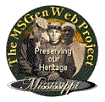|
WPA History of Lamar County, Mississippi
EARLY INHABITANTS
INDIANS
The Choctaw Indians were a friendly tribe. They made
baskets and traded them to the white people for meal. Many of
these baskets are still in use in this county. One of the oldest
settlers of the county, Mr. Sam Slade, says that he remembers
seeing the log with notches cut into it where the Choctaw Indians
beat corn into meal for bread. We still call our red corn Indian
corn and the bread King Bread.
All indications show that long before the Civil War the
place where Lumberton now stands was once an Indian village, also
a small tribe of Choctaw Indians remains there for a long time
after. In fact, Indian Bill spent his life here. He went from
place to place working for white people and is said to have been
a good hand. He was buried on Red Creek near where the tribe used
to camp.
There is an Indian mound on the north bank of Black Creek
about halfway between the bridges on the Jackson Highway and on
the Richburg Road. The mound is about 25 feet high. It was built
close to the bank of the creek on the flats or lowlands. At the
present time there are several large white oaks, red oaks and
magnolia trees and several pine trees have been recently cut and
removed from the mound. A visit to the mound shows that at
different periods there have been explorations into it but so far
as the writer knows nothing of interest has ever been discovered
or removed from the mound.
An Indian relic bearing the date 1771--five years before
the signing the Declaration of Independence of the American
Colonies--151 years before that in which it was found, was on
Wednesday deposited in Lamar County Bank, by W. I. Boone, father
of Ray Boone, the nine year old lad picked it up near his home on
Saturday, March 4, 1922.
When the lad brought the relic for his father's
inspection, the implement--a miniature tomahawk--was seemingly an
old piece of iron. Its form was that of a George Washington
hatchet, attracted sufficient attention to prompt Mr. Boone to
examine it closely. He soon discovered that he had a rare relic
and this was confirmed when Dr. M. J. Murphy had applied tests to
prove that the implement was made of gold and silver alloy with
inlaid figures and mountings of pure silver of artistic design
and carvings.
The jeweler who designed and manufactured the relic
followed closely the idea of a tomahawk, a weapon of warfare.
Manifestly, however, the trinket was meant for use as a pipe.
Suggestion has been made that it may have served as a pipe of
peace or was the cherished solacer of some Indian chief who
smoked the reed to smooth his spirits after a chase of deer or
bear or when resting from battle in which his tribe had
participated.
Irrespective of any conjectures as to the history of the
relic it is an interesting find, and the little golden pipe made
in the form of a weapon may prove of great ethnological value,
suggesting possibly, to those who decipher hieroglyphics, much of
interest relative to the extinct tribe of Natchez Indians. R. L.
Bennett has been given custody of the relic and authorized by Mr.
Boone to correspond relative to its intrinsic and historical
value.
In a letter to the Smithsonian Institutions Mr. Bennett
said, "It may interest you to know that I now have custody of
what local connoiseurs declare to be a valuable relic of Spanish
artcraft, made, evidently, for some Indian chief and possibly at
one time serving as a servitor of peace between warring tribes.
The relic was picked up here March 4, 1922--151 years after the
date, 1771, inscribed thereon in roman numerals."
"It is nothing less than an Indian tomahawk composed of
gold and silver alloy with pure silver mountings and a steel bar
serving as the blade of the tomahawk. It was manifestly not meant
as a real weapon of offense unless perchance the strong native
tobacco used by the tribal head was offensive to the ladies of
the wigwam as some indolent son of the forest lazily dozed while
he used the relic as his solacing pipe."
"The head or pole of the implement is hollow and
cylindrical and an opening into the eye of the blade appears to
have conveyed tobacco smoke into the stem for which the eye
served as an opening. A local metallurgist stated that the
implement is composed of silver and gold alloy in about the
proportions of two-thirds gold and one-third silver."
"The principal figure made by silver inlay and carved
radials is evidently meant to suggest the artists face of a
Sun-God. Another carving is the letter R crossed transversely
with double lines which descends and terminates in the form of a
pipe bowl."( Research work of T. W. Davis, Sr.; taken from the
Thursday, March 9, 1922 edition of the Booster.)
|



